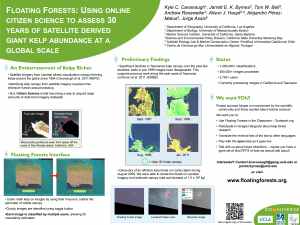Chilean Kelp & Floating Forest Scientists
One of the fun things about the FF project is that the science team is distributed all over the world – from Portugal to Boston to Santa Barbara to Chile. Recently, I got to go and work with Alejandro on some analyses of kelp removals on fish, and he took me out for a dive at his field site. It’s not giant kelp (that’s further south in Chile – and you’ll be seeing those images soon!) but Lessonia forms these awesome underwater forests that look like a bonsai Macrocystis forest. Ale shot some video of out explorations around an area that had been subjected to some strong snail herbivory, so I thought I’d share it with y’all.
Floating Forests at Western Society of Naturalists 2014!
Kyle, Alison, and I are just back from the annual meeting of the Western Society of Naturalists where we presented our progress with Floating Forests. The meeting took place in downtown Tacoma, Washington with over 500 marine ecologists, naturalists, and students in attendance.
We had some exciting discussions about the project at the poster session and the prospects of global coverage of kelp forest canopy dynamics has the potential to aid in the research of many scientists. Please click on the link below to download a high resolution copy of the poster.
Click Here for a Hi-Res Floating Forests Poster!
Great job everyone!
Color Corrected Images Back!
Welcome back to Floating Forests! We’ve had a few snafus that have been lowering the image quality that folk have mentioned, and we’ve got them locked down! What issues, some of you might be saying? During an image upload, something got snagged in the color translation, so images were coming out looking dark and red. Some users (thanks, artman40!) were quite skilled at seeing the kelp anyway. Hats off to you!

Yeah, that’s not an easy one. Interestingly, if you selected the image area, the scene pops out clearly.
We’re actually kind of excited about this, as it will give us a second validation dataset so we can really calibrate user views of images under different conditions. Some of the images that we have up there have been previously been viewed by research assistants (undergrads) at UC Santa Barbara. Part of our analysis of the data involves calibrating against any noise of different viewers looking at the same image. Now we’ll have three different classifications types for a set of the images – undergrad RAs, Floating Forest users, and Floating Forest users with a color-skewed dataset. It’s going to help us reduce error of estimation of kelp bed size and get better quality data in the end as we build better models of the data. There’s actually a nice article on just this topic in last month’s issue of Methods in Ecology and Evolution (one of my favorite journals!) (what, don’t look at me that way, I’m a scientist!)
A number of folk have asked us about the color skewing, and also asked us about the algorithm we use to select images. Stay tuned, as we’re working with Zooniverse to release the code they use to select images, and then anyone who is interested in having at it – either for their own applications (say, spotting coral reefs in the tropics, and needing to subset out only coastal images) or who is interested in trying to make our process better (and reduce the number of land images while not losing coastline images). We’d love to collaborate with more folk out there!



Recent Comments